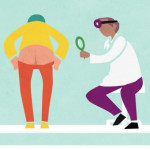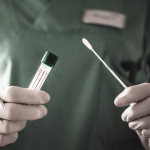What is lipodystrophy?
Lipodystrophy refers to two conditions: lipoatrophy, or fat loss, and lipohypertrophy, or fat accumulation.
Lipoatrophy involves the loss of subcutaneous fat under the skin, usually in the face, arms, legs and buttocks. It is most often seen in long-term survivors who took older HIV drugs, such as AZT (Retrovir or zidovudine) and d4T (Zerit or stavudine).
Lipohypertrophy typically involves fat gain in the abdomen surrounding the internal organs, which leads to a hard belly. Both women and men may experience breast growth, and some people develop a fat pad on the upper back known as a “buffalo hump.”
In some cases, fat buildup can cause discomfort, limit movement or interfere with sleep. Abdominal fat also raises the risk for heart disease and other health problems. What’s more, it can lead to emotional distress and discourage adherence to HIV treatment.
Lipoatrophy is difficult to reverse, but facial fillers can improve appearance. HIV-related fat gain may not respond to changes in diet or exercise, but a medication called Egrifta (tesamorelin) may help.

Istock
When should I start colon cancer screening?
The American Cancer Society recommends that people at average risk for colorectal cancer should start regular screening at age 45. Individuals with risk factors, such as a family history, can discuss earlier screening with their providers. Adults in good health should screen until at least age 75.
Options include colonoscopies every 10 years, flexible sigmoidoscopy (an exam of the lower part of the colon and rectum) every five years, stool DNA tests (such as Cologuard) every three years or tests for blood in the stool (such as fecal immunochemical testing, or FIT) every year. Positive stool tests should be followed up with a colonoscopy.
Colonoscopies and sigmoidoscopies require a special diet and preparation to empty your bowels. For stool tests, you usually collect a fecal sample using a kit and send it to a lab. All these methods can detect early colon cancer or precancerous changes known as polyps. The best test is the one you actually use!

Istock
Should I get screened for lung cancer?
Lung cancer screening using low-dose CT scans can detect cancer early, when it is easier to treat. The National Lung Screening Trial found that those who received annual scans had a lower risk of dying of lung cancer. But a recent study found that less than 2% of eligible people receive the recommended tests.
The United States Preventive Services Task Force recommends yearly lung cancer screening for people ages 55 to 80 who have a total smoking history of at least 30 pack-years—for example, smoking one pack of cigarettes a day for 30 years—and still smoke or have quit within the past 15 years, but a planned revision would lower the starting age to 50 and the pack-years to 20.
People with HIV may develop lung cancer at younger ages, so they may benefit from screening sooner.
Ask POZ is an ongoing section on POZ.com dedicated to answering general wellness questions. Go to poz.com/ask to read more answers, and email ask@poz.com to submit your questions!







Comments
Comments